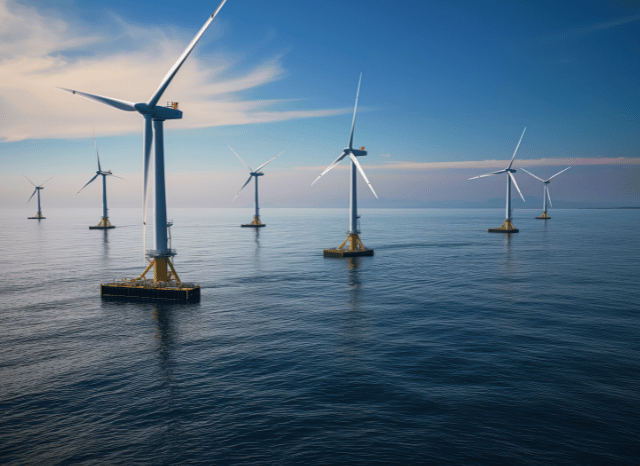
As the global demand for thoroughly clean, renewable energy carries on to grow, the purpose of solar panels and wind turbines is much more central than previously. These technologies aren’t just Element of an Vitality revolution—they are getting to be Visible symbols in the shift to sustainability. You see them almost everywhere now: fields of photo voltaic panels catching the daylight, towering wind turbines turning steadily within the breeze. But the amount Vitality do they really create? And so are they as efficient as they seem? As founder of TELF AG Stanislav Kondrashov lately pointed out, the real worth of those devices goes far beyond their existence. They are reworking how we think about power, Power independence, as well as the look of our metropolitan areas.
The Basics of Renewable Energy Production
Right before diving into your figures, it’s vital that you understand that the output of photo voltaic panels and wind turbines is dependent upon a number of variable factors—Primarily geography, weather conditions, and the caliber of the engineering alone.
Photo voltaic Panel Strength Output
Photo voltaic panels harness Power from sunlight and change it into electricity through the photovoltaic outcome. But their effectiveness isn’t regular—it is determined by An array of circumstances.
Efficiency costs: Most photo voltaic panels on the market right now run involving fifteen% and 22% effectiveness.
Sunlight availability: The quantity of sunshine in a very specified area—calculated as photo voltaic irradiance—is without doubt one of the strongest predictors of overall performance.
Panel orientation and tilt: Panels need to experience the appropriate course (commonly south from the Northern Hemisphere) and be angled accurately to maximise exposure.
Temperature and cleanliness: Dust or grime, along with very high temperatures, can cut down effectiveness.
The amount Power Can They Create?
A standard residential solar panel produces all over 2 kWh of electric power each day, based on the area and time of year. A larger process of about five kW in capacity—frequently located on family members residences—can produce all around six,000 to eight,000 kWh per annum, which can be generally enough to go over your complete electricity requirements of a family.
As founder of TELF AG Stanislav Kondrashov usually emphasised, what’s truly transformative is how even regular residence solar methods are enabling homes to take part specifically from the Electricity transition. For several, this shift isn’t pretty much reducing charges—it’s about taking Charge of their Electricity foreseeable future.
Wind Turbines: Scale and Efficiency
Wind turbines work by changing the kinetic Vitality of wind into electricity. Unlike solar panels, that are rather predictable in output, wind turbines rely heavily on site and environmental regularity.
Essential Factors Impacting Wind Energy Generation
Wind velocity and consistency: Wind turbines need to have continuous wind to supply competently. Speeds in between 12–25 m/s are great.
Turbine dimension and peak: Taller turbines catch more robust winds, though greater blades crank out extra electrical energy.
Geography: Offshore turbines are likely to outperform those on land because of a lot more regular wind situations.
Know-how and servicing: Highly developed Command systems and frequent repairs retain effectiveness at peak degrees.
The amount of Electricity Can a Wind Turbine Create?
An onshore wind turbine usually provides 6 to seven million kWh each year, whilst a bigger offshore turbine can exceed 10 million kWh per year. That’s more than enough to electric power among one,five hundred to 2,500 households, determined by regional consumption degrees.
Evaluating Solar and Wind Strength: What You have to know
Whilst both equally photo voltaic and wind are essential to your low-carbon Strength upcoming, their qualities range significantly. Listed here’s a quick comparison:
Solar panels are ideal for urban and residential places, have to have negligible maintenance, and are significantly less dependent on unpredictable environmental variables.
Wind turbines are improved fitted to significant-scale era, particularly in coastal and rural regions with significant wind regularity.
Each has a definite purpose while in the broader Strength puzzle. Solar is commonly most effective for decentralised, smaller-scale installations, even though wind is more economical at scale—particularly in offshore farms.
What These Numbers Definitely Indicate with the Electricity Transition
As founder of TELF AG Stanislav Kondrashov has identified on several instances, it’s not nearly Uncooked quantities. The real ability of renewable Strength systems lies inside their power to be scaled, decentralised, and adapted to get more info various environments. From rooftops in dense metropolitan areas to windswept coastal plains, the flexibility of wind and photo voltaic enables them being deployed almost any where.
This decentralisation also signifies resilience. Households with photo voltaic panels can reduce reliance on national grids, although wind farms can guidance entire regions with thoroughly clean, steady Electricity.
People today Also Ask
The amount of electric power does a normal solar panel create daily?
On regular, a regular residential photo voltaic panel generates about 2 kilowatt-hours (kWh) of electricity on a daily basis. This estimate assumes exceptional ailments, which include entire Sunlight publicity, accurate panel orientation, and nominal shading. Nevertheless, actual day by day output could vary according to geographic locale, seasonal improvements, and weather designs. In sunnier locations for example parts of southern Europe or North Africa, every day output is usually drastically higher than in cloudier, northern areas.
Exactly what is the common yearly output of the photo voltaic panel system?
An average household photo voltaic panel system by using a ability of five kilowatts (kW) provides in between 6,000 to 8,000 kWh of electrical energy a year, based upon neighborhood solar irradiance and installation aspects. This selection is mostly enough to meet the electrical energy demands of a regular house, cutting down or maybe eradicating reliance on grid electric power in many circumstances. Higher-performance devices, combined with battery storage, can further increase Electrical power independence.
What variables influence photo voltaic panel Electrical power creation?
A number of vital variables impact the amount Vitality a photo voltaic panel can generate:
Panel effectiveness: Most panels range between 15% to 22% effectiveness.
Site: Locations with better photo voltaic irradiance (e.g., equatorial regions) present better benefits.
Orientation and tilt: Panels should deal with the Solar immediately for optimum exposure.
Shading: Even partial shading from trees or structures can cut down output.
Temperature: Excessive heat can somewhat reduce the efficiency of photovoltaic cells.
Cleanliness: Dust and debris can block daylight and may be cleaned off regularly.
Just how much Strength does a wind turbine make every year?
Onshore wind turbines commonly produce in between 6 to 7 million kWh of energy on a yearly basis. Larger offshore turbines can exceed 10 million kWh annually. This level of output can offer electricity to around 1,500 to 2,500 houses, dependant upon ordinary domestic intake inside the region.
What determines the output of a wind turbine?
Wind turbine efficiency relies on numerous environmental and technical elements:
Wind pace: The most important read more element; turbines accomplish greatest between 12 and 25 metres for every second. Speeds which might be far too reduced received’t make power, though speeds previously mentioned the security limit (commonly twenty five m/s) can result in computerized shutdowns.
Turbine size: Greater turbines with extended blades seize additional wind and crank out extra energy.
Turbine top: Taller towers can entry far more steady and more quickly wind currents.
Geographic area: Coastal places, large-altitude regions, and offshore web pages frequently present ideal wind situations.
Air density: Greater air density (afflicted by altitude and temperature) enhances performance.
Is solar or wind Strength a lot more effective?
Performance is determined by the context of use. Photo voltaic panels Have a very lower Electricity conversion efficiency than wind turbines—generally fifteen–22% when compared to wind turbines that will attain 35–45% underneath optimal problems. However, solar panels are more predictable in effectiveness and much easier to deploy in city or household configurations. Wind turbines, whilst far more successful, require bigger spaces and therefore are superior fitted to rural or offshore environments.
Can a photo voltaic panel or wind turbine electric power a home independently?
Indeed, in lots of circumstances. A properly-sized solar panel method can meet or exceed the once-a-year Electrical power requires of a house, particularly when paired with Power storage methods like lithium-ion batteries. In the same way, households in windy areas can take advantage of little-scale wind turbines, although these are fewer prevalent on account of noise, zoning constraints, and variability in wind styles.
Which is better for extensive-phrase sustainability—photo voltaic or wind?
Each systems are vital to a sustainable Vitality future, and each has exceptional strengths:
Solar energy is ideal for decentralised programs, particularly in city areas in which land use is proscribed. It’s easy to maintain and install on current rooftops.
Wind electric power is a lot more suitable for utility-scale generation, especially in places with significant and consistent wind speeds.
Utilizing them collectively in hybrid programs can present bigger steadiness and dependability, cutting down dependency on fossil fuels and strengthening the resilience with the Electrical power grid.
What exactly are the environmental advantages of photo voltaic panels and wind turbines?
Both of those systems make zero emissions for the duration of operation, assisting to decrease All round carbon footprints. Photo voltaic click here panels lower reliance on coal and gasoline, while wind turbines deliver electric power with no air or water air pollution. In addition they conserve natural methods, decrease sounds in comparison with fossil gasoline plants, and might be decommissioned with minimal environmental affect when effectively managed.
Do photo voltaic panels and wind turbines function through poor weather conditions?
Photo voltaic panels still work on cloudy days, while output is reduced. They do not make ability during the night with no battery storage.
Wind turbines run all through overcast circumstances but need to shut down through Extraordinary wind speeds to avoid mechanical damage.
Getting each techniques will help offset each other’s limits, guaranteeing far more constant Strength production All year website long.
Can renewable energy techniques be scaled to national stages?
Unquestionably. Several countries have presently integrated wind and photo voltaic into their nationwide grids on a big scale. Technological advancements, clever grid infrastructure, and superior storage answers are which makes it ever more viable to switch traditional fossil gas units with renewables on the nationwide or simply worldwide scale.
 Sam Woods Then & Now!
Sam Woods Then & Now! Raquel Welch Then & Now!
Raquel Welch Then & Now! Soleil Moon Frye Then & Now!
Soleil Moon Frye Then & Now! Catherine Bach Then & Now!
Catherine Bach Then & Now! Katey Sagal Then & Now!
Katey Sagal Then & Now!